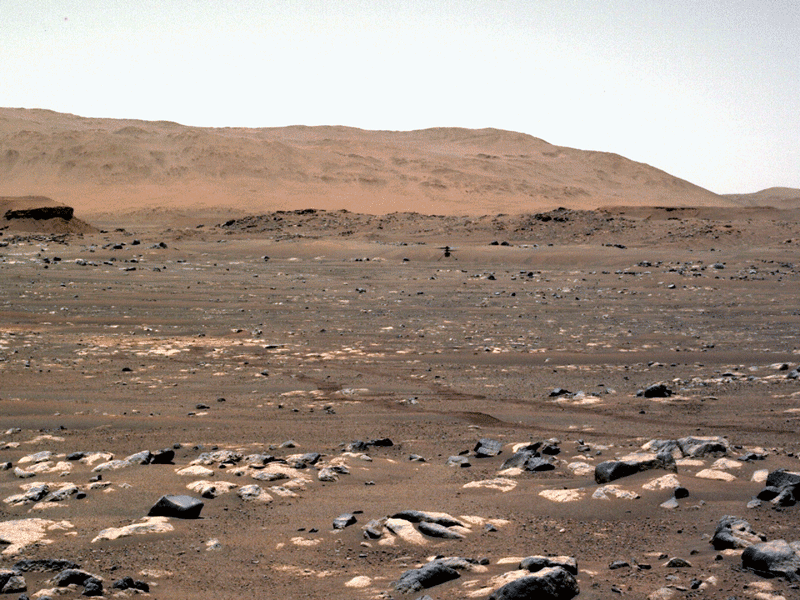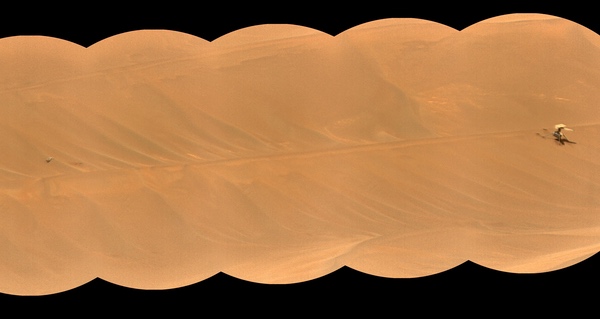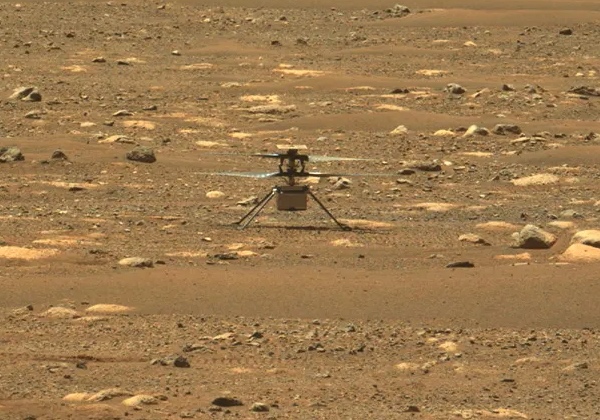The ongoing triumph of Ingenuityby William Pomerantz
|
| As the landing date for Perseverance and Ingenuity approached, I asked my JPL friends for their guesses as to how many times the helicopter would fly. By far the most common answer was that it would never make it off the ground in one piece. |
As I learned more about the idea, I marveled at the balance between the simplicity of the overall concept and the complexity of some of the engineering specifics required to make a helicopter fly on a planet where the atmospheric pressure at the surface is only 1% of what it is here on Earth (where it's already extremely challenging to make helicopters fly!).
While many people, myself included, were wondering what was possible, small teams at JPL and AeroVironment were creating what was possible. A quick, hardware-rich sprint by a team of incredible engineers, technicians, and project managers allowed the Ingenuity Mars helicopter project to be completed on schedule—words we too rarely get to say in the world of space exploration.
As the landing date for Perseverance and Ingenuity approached, I asked my JPL friends for their guesses as to how many times the helicopter would fly. By far the most common answer was that it would never make it off the ground in one piece. Another subset of people thought Ingenuity might fly once or twice.
After the nerve-wracking deployment of the helicopter from under the belly of Perseverance, followed by a few weeks of wiggling rotors and commissioning the vehicle, the world was treated to what you see in this GIF: the first aircraft to perform powered, controlled flight on a planet other than Earth.
 (credit: NASA/JPL-Caltech) |
This was a “Wright Brothers moment,” happening in our lifetimes, on another world. The impossible becoming possible. A new mode of peaceful exploration, coming online right before our eyes, in glorious full-color video.
Over the next three Earth years, Ingenuity would go on to surpass every expectation. From an initial target of five flights and 30 Martian days (sols), Ingenuity achieved 72 flights and about 1,000 sols. Ingenuity flew higher, faster, and further over more hazardous terrain than ever imagined. It returned first-of-its-kind images of the Perseverance rover, its backshell, and more. It gave us up-close images of Martian vistas that we're currently unable to explore by rover or with orbiters. The little helicopter that could survived a Martian winter with barely any damage. Every day, every flight, every image brought us precious new knowledge and expanded the horizons of humanity’s understanding of our closest planetary neighbor.
Along the way, some of the rover-centric teammates who had first seen Ingenuity as a distraction came to view the helicopter as an incredible new tool. The operations team is constantly faced with deciding between sending the rover to explore the most interesting territory and avoiding those same areas if the landscape might damage and strand the rover. It’s a tension that the JPL team is extraordinarily good at managing, but a tension nonetheless.
| If the choice ever became stand down or keep pushing, the team wanted to keep pushing. |
About 60 flights into Ingenuity’s planned five-flight mission, I had the great honor of joining AeroVironment to run the team responsible for our contributions to Ingenuity and the next generation of Mars helicopters. Ingenuity was still in excellent condition and was responding to every new challenge we gave it, making aerial exploration of Mars seem almost easy. But still, as we started what was effectively our 12th victory lap after a race well run, we knew that every day Ingenuity phoned home was a gift.
As I got to know the team at AeroVironment and as I became reacquainted with the JPLers on the mission, one of the questions I asked was how people would like to see the mission end. We all wanted to see Ingenuity complete as many flights as possible; but I wanted to hear what the people who quite literally built Ingenuity thought. Should Ingenuity earn a quiet retirement in some picturesque location? Or should we push the edges of the envelope until at last we ask Ingenuity to do something it can’t manage, and see it fail in flight?
I received a range of strongly held responses to my question, but the overwhelming majority of the Ingenuity team was aligned. They reinforced that this mission was designed as a technology demonstration, and the best way to honor the spirit of Ingenuity was to ensure that the vehicle kept teaching us new things about flight on Mars, right up to the end. If the choice ever became stand down or keep pushing, the team wanted to keep pushing.
And that’s exactly what happened. After more than 70 flights, we encountered a technical challenge that was simply beyond Ingenuity’s capabilities. The helicopter’s visual navigation system couldn’t distinguish the features of a very monotonous landscape well enough to consistently track them. Lacking that information, the vehicle essentially became confused about where it was and where it was going. As it descended, it may have begun to chase its own shadow.
At some point during the flight and landing, Ingenuity sustained significant damage to its rotor blades and yet, somewhat miraculously, it survived that landing and came to rest upright on the Martian surface. Ingenuity is still alive and sending home data from its onboard systems—something it may continue to do for years to come. Perhaps if the Perseverance rover drives back by Valinor Hills Station (Ingenuity’s final airfield, named for Tolkien’s Undying Lands), Ingenuity will be able to phone home again and relay years’ worth of weather data to scientists on Earth. But unfortunately, it will never fly again.
Seventy-two flights. More than two hours of flying time. Over 1,000 sols after arriving on Mars. Eleven miles (17.7 kilometers) covered. All this from a helicopter that weathered rocket launch loads, Martian dust storms, and more without a single opportunity for in-person inspection or servicing—something you’d never expect of a helicopter here on Earth. Ingenuity gave us everything we asked for and more.
True to its spirit and its mission, even Ingenuity’s final flights have made us smarter. There’s more yet to learn, but from what I’ve seen, I believe the challenge that grounded Ingenuity will be relatively easy to overcome with future Mars helicopters, thanks to what we’ve now learned. Yes, Ingenuity reached a limit; but that limit can and will be conquered. Flight 72 marked an end, but not the end.
The true conclusion of the Ingenuity mission will come when its hard-earned lessons are next put into practice by another Mars helicopter, one that will be even more ingenuous than its predecessor, thanks to how much wiser we are after 72 flights.
AeroVironment has continued to invest funds and time into dreaming up new capabilities for future Mars helicopters. Engineers at AeroVironment, JPL, and NASA Ames are now thinking about helicopters and other aerial vehicles that could someday carry scientific instruments, fetch sample tubes, or explore difficult to access locations such as valleys and lava tubes.
Additionally, elsewhere in the world, others are following Ingenuity’s lead. In 2021, China announced its plans to fly a helicopter on Mars, and more recently, India has revealed more about its plan to fly a Martian helicopter with a variety of weather and atmospheric sensors within the next eight years. With a growing community of international space agencies interested in the exploration of the Red Planet, helicopters may become an affordable and attractive option for space discovery and diplomacy.
| I believe the impactful legacy of Ingenuity will do for aerial mobility on Mars what Sojourner did for ground mobility. |
When the Ingenuity mission began, NASA’s leaders often compared it to the Wright Brothers 1903 Flyer—and indeed, Ingenuity carried a small piece of fabric from that historic aircraft to Mars. Now that the Martian equivalent of the Kitty Hawk flight has occurred, the successors to Orville and Wilbur at NASA JPL and AeroVironment are itching to embark on the next great endeavor that will forever change the future of planetary exploration. Planetary exploration helicopters have made their impact and are here to stay, and those in government, academia, and industry who embrace and support the inclusion of these systems in future missions will surely reap the benefits.
Another novel forebearer of Ingenuity is Sojourner, the first successful Mars rover. Like Ingenuity, Sojourner was the lighter, smaller vehicle that hitched a ride with another mission to the Red Planet. Both programs had small budgets but delivered huge results.
I believe the impactful legacy of Ingenuity will do for aerial mobility on Mars what Sojourner did for ground mobility: leave such an impactful legacy that at every future Martian launch window, and with every future call for proposals, this new form of exploration demonstrated by Ingenuity is considered a critical enabling technology for future discovery.
As Ingenuity’s flying campaign comes to an end, and as the era of aerial Mars exploration begins in earnest, my hat is off to the people who made this possible, including brilliant NASA and JPL colleagues like Bob Balaram, Charles Elachi, Mimi Aung, Robert Hogg, Bobby Braun, Theodore (Teddy) Tzanetos, Håvard Grip, and more, and AeroVironment colleagues Matt Keennon, Benjamin Pipenberg, Sara Langberg, Jeremy Tyler, Joey Beckman, and more. Humanity’s best machines reflect the care, cleverness, and curiosity of their makers—and with Ingenuity, each of you has proven to be truly world-class.
 A mosaic shows the final resting place of Ingenuity (right) as well as one of rotor blades. [larger version] (credit: NASA/JPL-Caltech/LANL/CNES/CNRS) |
Note: we are now moderating comments. There will be a delay in posting comments and no guarantee that all submitted comments will be posted.
